| Pages:
1
2 |
benzylchloride1
Hazard to Others
  
Posts: 299
Registered: 16-3-2007
Member Is Offline
Mood: Pushing the envelope of synthetic chemistry in one's basement
|
|
The synthesis of 1 and 2-naphthols from Napththalene
Theory behind the synthesis
1 and 2 naphthols are interesting phenolic compounds that can be produced in 2 steps from naphthalene which is readilly available in the form of moth
balls. These 2 isomeric phenols are useful intermediates for the synthesis of catalysts, dyestuffs and quinone derivatives. The synthesis involves the
sulfonation of naphthalene, isolation of the sulfonic acid as the sodium salt, fusion of the sodium sulfonate with potassium hydroxide and
acidification of the fusion product to produce the crude product. The 2 isomers of the sulfonic acid can be produced by varying the temperature of the
sulfonation reaction. Below 60 degrees celsius, the 1-sulfonic acid predominates, while at higher temperatures the 2-sulfonic acid predominates. This
is an example of kinetic versus thermodynamic control of a chemical reaction. The 1-isomer is the kinetic product, it forms quicker at lower
temperatures, while the 2-isomer is the thermodynamically more stable product and forms quickly at high temperatures. To produce sodium 1-naphthalene
sulfonate, the naphthalene is stirred with the sulfuric acid at about 50 degrees celsius until all of the naphthalene dissolves forming the sulfonic
acid. The solution of sulfonic acid is then diluted with water, partially neutralized with sodium bicarbonate and salted out with sodium chloride at
the boiling point, this causes fine crystals of the product to seperate. The product is then filterd off and dried in a drying oven at 100 degrees
celsius. To produce the 2-isomer, the napthalene is heated to 160 degrees celsius and the sulfuric acid rapidly added. After the mixture is
homogenous, the solution is poured into water and worked up in the same fashion as the 1-isomer. To produce the 1 or 2 naphthol, the sodium
naphthalene sulfonate is fused in a copper crucible with potassium hydroxide at about 300 celsius. Sodium hydroxide can be used, but potassium
hydroxide produces a cleaner product and the fusion reaction works better. A larger quantity of sodium hydroxide would have to be used to get the
mixture to fuse properly. The use of potassium hydroxide results in a more fluid melt that is easier to stirr and the reaction is less violent then
that of the sodium hydroxide. A safety warning is appropriate at this point: Caustic alkali at 300 celsius is extremly dangerous; the fusion step must
be conducted in a fume hood with the sash pulled down to protect the chemist. a laboratory coat, safety goggles and gloves must be worn at all times!
Experimental:
sodium 1-naphthalene sulfonate
A 1000 mL 3-necked flask was placed in a Buchi rotovapor water bath. A mechanical stirrer was attached to the flask and a thermometer placed in one of
the necks. 50g of powdered naphthalene was placed into the flask through the open neck using a powder funnel. A addition funnel was then placed in
neck of the flask. The stirrer was started and 50 mL of 92% sulfuric acid was poured into the flask. Water was placed in the water bath and the water
bath was heated to about 45 celsius. The naphthalene slowly dissolved, forming a light purple colored solution. The temperature was regulated to keep
the reaction mixture from going above 60 celsius. After the naphthalene had dissolved, 4 hours, the mixture was poured into 400 mL of waterin a 1L
beaker. The flask was then washed with water and the washings added to the solution in the beaker. The solution was then filtered to remove a small
amount of unreacted naphthalene. 20 g of sodium bicarbonate was then added in small portions to the mixture which was rapidly stirred by hand. The
mixture was then heated to boiling and about 35g of finely powdered sodium chloride was added to the mixture with rapid stirring. The sodium
1-naphthalene sulfonate crystallizes out of the solution at the boiling point. The mixture was then allowed to crystallize for several hours in a ice
bath. The mixture than consists of a thick mass of crystals that fills the solution. The crystals are then filtered off using vacuum filtration to
speed the process. The product can be recrystallized from a sodium chloride solution using the same salting out process with a much smaller amount of
sodium chloride. I did not recrystallize my product to save time. The product was then broken out of the filter and allowed to air dry for about a
day. Then it was dried in a drying oven set at 100 celsius for several hours or until the product was bone dry. The product was than ground up and
placed in a tared bottle. In my experiment the product weighed over the theoretical (90g) because of occluded salts in the product from not
recrystallizing.
I am currently working on the fusion of the sodium 1-naphthalene sulfonate, more to come in the next month.
[Edited on 4-1-2009 by benzylchloride1]
|
|
|
not_important
International Hazard
    
Posts: 3873
Registered: 21-7-2006
Member Is Offline
Mood: No Mood
|
|
Just a quick note that a mix of KOH/NaOH sometimes works even better, and fuses ay a lower temperature while being less costly. There are some liquid
drain clearer productions that are a concentrated solution of NaOH+KOH, and make a decent starting point.
|
|
|
benzylchloride1
Hazard to Others
  
Posts: 299
Registered: 16-3-2007
Member Is Offline
Mood: Pushing the envelope of synthetic chemistry in one's basement
|
|
The alkali fusion of the sodium sulfonates:
The procedure I used came from Vogels practical Organic Chemistry, which called for a 250 mL copper crucible. I only had a 2 inch copper end cap to
use as a crucible for this reaction, so the required chemicals where divided by 1/10 and ten fusion runs were made. 12 grams of potassium hydroxide
obtained off of Ebay were placed in the crucible and 0.5 mL of water was then added. 5.0g of sodium 1-naphthalene sulfonate was than weighed out. The
cruicible was then heated in the fume hood with the sash pulled pown with a propane torch. Once the potassium hydroxide had melted, the sulfonate was
added in one portion and rapidly stirred by hand with a spiral copper wire attached to a metal shaft. The melt was initially light grey, but the
colored turned green over a peroid of about a minute or two. The mixture was heated with stirring until the mixture began to froth up. The heating was
removed and the mixture was stirred until the reaction subsided. The mixture was then cautiously heated until the frothing ceased and a brown oil had
separated on top of the alkali. The mixture was then heated for an addition 2 minutes before being poured on to a piece of sheet metal to harden and
cool. This was repeated ten times which equaled 50 g of sodium 1-naphthalene sulfonate, 120g of potassium hydroxide and 5 mL of water. This procedure
can also be conducted all at once in a 250 mL copper crucible.The fusion product was than added to 300 mL of water in a 1000 mL beaker. The fusion
product was than dissolved with stirring for about 15 to 20 minutes. Concentrated hydrochloric acid was then slowly added with stirring. The mixture
must be kept from boiling which would cause the lost of some of the product during the addition of the acid. The heat produced from the neutralization
assists in consolidating the product making it easier to filter. The acid is added until the pH is around 4 or 5 which is around the point that large
quantities of sulfur dioxide are produced from the reaction of the sodium sulfite produced in the reaction with the hydrochloric acid. The 1-naphthol
precipitates during this process as a brown crystalline solid. The mixture is than cooled in an ice bath for several hours and the filtered. The wet
1-naphthol is then placed in a 1 L beaker and covered with about 300 mL of water. Enough 50% sodium hydroxide solution is then added to dissolve the
naphthol; do not use an excess. The solution is now very dark in color. The solution is then filterd into a 500 mL flask and hydrochloric acid is now
slowly added until the solution is acidic and the napthol precipitates as a finely divided white precipitate. The solution is than allowed to cool and
is filtered off with a vacuum filtration apparatus. The product is than pressed with a piece of saran wrap until it is fairly compacted and most of
the water is forced out. The product is than removed from the funnel, broken up and allowed to dry on several paper towels for about 2 days. My
product is currently drying in my fume hood. I will report back as soon as the product is dry with a melting point and percentage yield.
|
|
|
kclo4
National Hazard
   
Posts: 916
Registered: 11-12-2004
Location:
Member Is Offline
Mood: No Mood
|
|
You'd have a pretty good procedure if you had some pictures I think.  Also if you
converted a file into a PDF so we can all keep a copy! Great job on making the naphthols. I would be a little bit worried of their carcinogenicity
though, I know one isomer of naphthylamine is a known human carcinogen, and the naphthols may be as well. Also if you
converted a file into a PDF so we can all keep a copy! Great job on making the naphthols. I would be a little bit worried of their carcinogenicity
though, I know one isomer of naphthylamine is a known human carcinogen, and the naphthols may be as well.
Anyways, thanks I like how easy this procedure is.
|
|
|
UnintentionalChaos
International Hazard
    
Posts: 1454
Registered: 9-12-2006
Location: Mars
Member Is Offline
Mood: Nucleophilic
|
|
| Quote: | Originally posted by kclo4
You'd have a pretty good procedure if you had some pictures I think.  Also if you
converted a file into a PDF so we can all keep a copy! Great job on making the naphthols. I would be a little bit worried of their carcinogenicity
though, I know one isomer of naphthylamine is a known human carcinogen, and the naphthols may be as well. Also if you
converted a file into a PDF so we can all keep a copy! Great job on making the naphthols. I would be a little bit worried of their carcinogenicity
though, I know one isomer of naphthylamine is a known human carcinogen, and the naphthols may be as well.
Anyways, thanks I like how easy this procedure is. |
Phenol and aniline aren't exactly health products either (nor are most things we consider interesting on this site), but phenol is still used as an
antiseptic. Google Chloraseptic.
Food dyes of the azo variety sometimes have a naphthol moiety, and they don't seem to be too toxic. Not to mention that the azo bond gets cut
somewhere in your body, releasing in the case of say, red 40, a 2-naphthol sulfonic acid.
Department of Redundancy Department - Now with paperwork!
'In organic synthesis, we call decomposition products "crap", however this is not a IUPAC approved nomenclature.' -Nicodem
|
|
|
benzylchloride1
Hazard to Others
  
Posts: 299
Registered: 16-3-2007
Member Is Offline
Mood: Pushing the envelope of synthetic chemistry in one's basement
|
|
The 1-naphthol was obtained as a off white solid in a yield of 70% that melted at 90 celsius which is slightly blow the literature value. The
naphthols are toxic and may be carcinogenic which most interesting and not interesting chemicals are. The naphthylamines are carcinogenic, especially
the 2-isomer which is a known human carcinogen from way back. 1-naphthol can also be produced by nitrating naphthalene, reducing to 1-naphthylamine
and running a reverse Bucherer reaction with sodium bisulfite to produce the 1-naphthol. I would not advise this method unless you are working in a
out building with a suitable fume hood. I am currently trying to improve my ventilation system for my 4-foot Kewaunee fume hood so that I can conduct
chlorination reactions. The interior of the fume hood is stainless steel and hydrochloric acid is not to friendly to it. When I conduct the 2-naphthol
synthesis, I will post some picture of the procedure. I recently synthesized some ammonium 2,4-dinitronaphthol from the 1-naphthol. This is the first
intermediate in the Maritius Yellow series of synthesises in Fieser's textbook.
|
|
|
benzylchloride1
Hazard to Others
  
Posts: 299
Registered: 16-3-2007
Member Is Offline
Mood: Pushing the envelope of synthetic chemistry in one's basement
|
|
I conducted the synthesis of sodium 2-naphthalene sulfonate today. I used the procedure in Vogels. I forgot to take pictures again. 100g of
naphthalene was placed in a 500ml 3-neck flask. The flask was heated with a heating mantle. The mixture was mechanically stirred with a stirring motor
using the home made stirring bearing described in Fiesers textbook. A addition funnel and thermometer was placed in the other two necks of the flask.
The naphthalene was melted and the stirrer was started. Glascol mantles are wonderful, beats heating with a hot plate or burner. The liquid
naphthalene was heated to 160 Celsius. 90ml of 92% sulfuric acid was run in over a peroid of 10 minutes. The mixture turned to a purple color and then
almost black. The mixture was stirred for an additional 5 minutes after the additon of the sulfuric acid. The apparatus was disassembled and the
sulfonated naphthalene was then carefully poured with stirring into 750ml of water in a 1000ml beaker. A fine precipitate formed. 4 grams of
decolorizing charcoal was added and the solution was heated to boiling and filtered. The dark solution was partially neutralized by adding 40 grams of
sodium bicarbonate in small portions with stirring. The solution was heated to boiling and 70 grams of finely powdered sodium chloride was added with
stirring. the sodium salt precipitated instantaneously. upon cooling, the contents of the beaker completely solidified. The solid was then filtered
and pressed to remove most of the mother liquer. The crude product was then recrystallized from 700ml of water. The product crystallized as small
plates. The crystallizing salt is being left over night at room temperature to complete the crystallization.
Amateur NMR spectroscopist
|
|
|
Paddywhacker
Hazard to Others
  
Posts: 478
Registered: 28-2-2009
Member Is Offline
Mood: No Mood
|
|
I am tempted to try this out, as I have been thinking of buying the two naphthols, but don't like the asking price.
A quick internet search shows that a mixture of 41% NaOH and 59% KOH melts at 170 Celsius, or maybe lower if commercial water content is taken into
account.
|
|
|
benzylchloride1
Hazard to Others
  
Posts: 299
Registered: 16-3-2007
Member Is Offline
Mood: Pushing the envelope of synthetic chemistry in one's basement
|
|
Some alkali fusions can be conducted with mixtures of potassium and sodium hydroxides. I have had consistently bad results when using pure sodium
hydroxide. After filtering, pressing, drying the product over a wood burning stove and then powdering and further drying the product at 80 Celsius a
fine off white powder was obtained. The product weighed 98 grams which gives a percentage yield of 54%. The fairly low percentage yield was due to not
salting out the product druing the recrystallization. I have enough sodium 2-naphthalene sulfonate to make 2 batchs of 2-naphthol according to the
procedure in Vogel. I may trying synthesizing p-cresol from toluene using the method provided in Vogel for this compound using a mixed alkali fusion
in the near future.
[Edited on 12-4-2009 by benzylchloride1]
[Edited on 12-4-2009 by benzylchloride1]
Amateur NMR spectroscopist
|
|
|
16MillionEyes
Hazard to Others
  
Posts: 153
Registered: 11-3-2007
Location: 16 Million Eyes, US
Member Is Offline
Mood: No Mood
|
|
I agree with others that pictures would be nice. In addition--not that I'm the best writer or anything--I think it would be easier to read what you
wrote if you broke down your sentences into paragraphs.
As for the chemistry, I'm actually disheartened to know that most naphthalene seems to be slowly being replaced by p-dichlorobenzene. I have tried to
think of something interesting and easy to do with this compound but all I can think of is out of my league. For the napththalene reaction it seems
like it is relatively easy to do. I'd figured it would be in the ranks of benzene, but apparently it isn't so and it's much friendlier in terms of
reaction conditions.
|
|
|
Paddywhacker
Hazard to Others
  
Posts: 478
Registered: 28-2-2009
Member Is Offline
Mood: No Mood
|
|
p-dichlorobenzene
Before Christmas, I sealed up 0.1 mole of p-dichlorobenzene (PDCB) in a jar with 0.25 moles of potassium iodide and about 150 ml of acetone.
The idea was that I'd get p-diiodobenzene out of it, but my lab is in transition while I install subzero cooling for my rotovap, and I haven't done
anything for months.
I did open the jar at one stage but got frustrated trying to work out a TLC protocol for checking the reaction.
But that begs the question .... what to do with p-diiodobenzene.
At one stage last year I tried to nitrate PDCB by prolonged reflux, but during workup I pulled the tap out of the separating funnel and the product
soaked into my carpet.... but there was some yellowish goodness there.... I think.
[Edited on 13-4-2009 by Paddywhacker]
|
|
|
UnintentionalChaos
International Hazard
    
Posts: 1454
Registered: 9-12-2006
Location: Mars
Member Is Offline
Mood: Nucleophilic
|
|
Feel free to delete my useless contribution if you see fit.

Department of Redundancy Department - Now with paperwork!
'In organic synthesis, we call decomposition products "crap", however this is not a IUPAC approved nomenclature.' -Nicodem
|
|
|
nitric
Harmless

Posts: 40
Registered: 18-8-2008
Member Is Offline
Mood: nitrous
|
|
i attempted this with the first part of the sythesis, and the sulfonic acid crystalizes out of the sulfuric acid if left for about 24 hours with a
perfect 1:1 (grams:ml) ratio of reacted naphthalene and sulfuric acid.
|
|
|
benzylchloride1
Hazard to Others
  
Posts: 299
Registered: 16-3-2007
Member Is Offline
Mood: Pushing the envelope of synthetic chemistry in one's basement
|
|
Sulfonic acids can usually be recrystallized from concentrated hydrochloric acid. A glass fritted funnel is needed to filter of the product because
the sulfonic acid and solvent will quickly destroy any filter paper.
Amateur NMR spectroscopist
|
|
|
nitric
Harmless

Posts: 40
Registered: 18-8-2008
Member Is Offline
Mood: nitrous
|
|
I can usually filter conc. HCl but not conc. H2SO4. The fusion part can be done with a glass vessel if you don't care about it, i cant see the copper
catalyzing any reactions since its often just done in a iron or ceramic vessel in literature as far as I've heard
|
|
|
len1
National Hazard
   
Posts: 595
Registered: 1-3-2007
Member Is Offline
Mood: NZ 1 (goal) - Italy 1 (dive)
|
|
Quote: Originally posted by Paddywhacker  | I am tempted to try this out, as I have been thinking of buying the two naphthols, but don't like the asking price.
A quick internet search shows that a mixture of 41% NaOH and 59% KOH melts at 170 Celsius, or maybe lower if commercial water content is taken into
account. |
This can't be right. Where on the internet did you find this info?
|
|
|
nitric
Harmless

Posts: 40
Registered: 18-8-2008
Member Is Offline
Mood: nitrous
|
|
Quote: Originally posted by Paddywhacker  |
A quick internet search shows that a mixture of 41% NaOH and 59% KOH melts at 170 Celsius, or maybe lower if commercial water content is taken into
account. |
I have heard simialar information about KOH and NaOH mixtures that melt at lower temperatures than both, it may have been on Bromic's book project and
wiki
|
|
|
not_important
International Hazard
    
Posts: 3873
Registered: 21-7-2006
Member Is Offline
Mood: No Mood
|
|
| Quote: | | Abstract A eutectic etchant consisting of 50 mole percent KOH and 50 mole percent NaOH has been developed having a melting point of 170°C.
|
http://www.springerlink.com/content/g8u4176564648817/
| Quote: | The mixture of NaOH and KOH preferably contains NaOH and KOH in the molar range ratio of 70:30 to 30:70. It is particularly preferred to use mixtures
whose composition is close to that of the eutectic mixtures, e.g. 65:35 to 57:42 and 45:55 to 55:45 (NaOH:KOH).
A mixture of NaOH and KOH in a molar ratio of 1:1 form an eutectic mixture melting at 170° C., which has a low viscosity. |
US Patent 4769359
| Quote: | | In the molten hydroxide fluxes 20 g of the equimolar eutectic NaOH (8.32g) / KOH (11.68g) were fused at 185ºC (the theoretical melting point of the
mixture is 170ºC) in a Teflon crucible exposed to the atmosphere in a sand bath. |
http://boletines.secv.es/upload/20070308163709.43%5B2%5D220-...
| Quote: | | The mixture of NaOH and KOH melts at and is the lowest melting binary mixture among the alkali and alkaline earth hydroxides. |
http://scitation.aip.org/getabs/servlet/GetabsServlet?prog=n...
|
|
|
Magpie
lab constructor
    
Posts: 5939
Registered: 1-11-2003
Location: USA
Member Is Offline
Mood: Chemistry: the subtle science.
|
|
Here's my recent experience at making sodium 2-napthalene sulfonate (SNS). This will be used later as a precursor in making 2-naphthol.
My first attempt was a half-batch (32g naphthalene charge) using the procedure in Gattermann (1937), forum library. This was a complete failure
yielding no product. I attribute this to the requirement for a 4-hr cook at 170-180C which resulted in virtually all of the naphthalene evaporating.
This occurred despite my attempt to restrict evaporation by using an Erlenmeyer flask.
Seeing upthread that benzylchloride1 had successfully made SNS using the procedure in Vogel's 3rd, this was tried. This only required a 10 minute
cook at 160C, and was done at a larger scale (100g naphthalene charge). This was successful and yielded 124g of SNS compared to Vogel's predicted
140g.
SNS is very soluble in water and is therefore salted out using a 10% solution of NaCl. I found that it took 600g of the boiling salt solution to
dissolve 30g of SNS. The picture below shows the recrystallization (overnight) in the 10% NaCl for 1/2 of the batch.
Attachment: phpLoPp1x (89kB)
This file has been downloaded 1434 times
Recrystallization in 10% NaCl
The crystals were then sucked dry and pressed using a Buchner funnel, then dryed overnight in a 100C oven. I used regular filter paper in the Buchner
funnel but it had to be replaced regularly due to acid attack. The picture below shows the lustrous flake crystals for 1/2 of the batch.
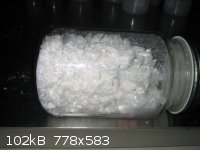
sodium 2-naphthalene sulfonate crystals
Discussion
My guess is that the 4-hr cook in the Gattermann (and Fierz-David) procedure was taken from a large scale industrial procedure. In that case
surface/volume ratio and equipment provisions were such that excessive evaporation of the naphthalene was not a problem. Anybody else have an opinion
on this?
It is interesting to me that the Vogel procedure (as did Fierz-David, but not Gattermann) only calls for partial neutralization of the 2-naphthalene
sulfonic acid initially produced. NaHCO3 is used for this. My resulting pH was about 2 using pH paper. My question is why only partial
neutralization?
Incidentally, I made a mistake and used 40g of Na2CO3 instead of 40g of NaHCO3. Since I was still carrying an acidic product I went ahead and
finished up the synthesis. Unfortunately I really have no way of determining the purity of my product. All I can say at this point is that it looks
good.
[Edited on 8-12-2012 by Magpie]
[Edited on 8-12-2012 by Magpie]
[Edited on 9-12-2012 by Magpie]
[Edited on 9-12-2012 by Magpie]
The single most important condition for a successful synthesis is good mixing - Nicodem
|
|
|
Magpie
lab constructor
    
Posts: 5939
Registered: 1-11-2003
Location: USA
Member Is Offline
Mood: Chemistry: the subtle science.
|
|
Using the procedure in Vogel’s 3rd I have prepared 2-naphthol using recently prepared sodium 2-naphthalene sulfonate (SNS). This was a high
temperature caustic fusion using KOH.
A. Equipment
Vogel specifies a 250mL metal crucible mounted in a piece of asbestos sheet for the fusion. Not having any asbestos I substituted an 8” square x
¼” sheet of Hardie board, a fireproof, cement-like siding material. For the crucible I used a ½ pint ss measuring cup. See picture below:
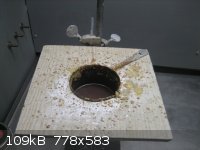
ss crucible in Hardie board
A 3/8” copper tube was used to protect the thermometer which was also used to stir the reactants during the fusion.
B. Fusion
The 50g of SNS was first ground to a fine powder in a coffee grinder. 120g of flake KOH and 5mL of water were then heated to 250°C in the crucible
using a Meker burner on propane. The SNS was then added and stirred into the liquid KOH. There was barely enough room in the crucible.
As the temperature reached 310°C the fused mass produced a brown oil that floated on the molten KOH. The mass also began spitting. I wore 2 heavy
shirts, a lab apron, and a pair of leather gloves. The hood window was down to protect my face and the fan was on. I regard these safety
measures as essential. After heating was completed the fused mass was ladled into a 1-liter beaker half filled with crushed ice using the
spoon end of a spatula. Results can be seen in the picture below which was taken after the fusion was completed
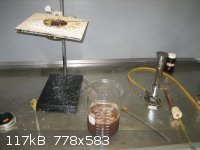
aftermath of the fusion to 2-naphthol
C. Precipitation
Following the melting of the ice ~170mL of con HCl was added to the beaker to precipitate the 2-napthol. The picture below shows this precipitation
in progress:
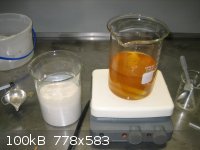
precipitation of 2-naphthol from sodium 2-naphtholate
Then just enough 5% NaOH was added to redissolve the 2-naphthol (~110mL). 1g of sodium dithionite was added to prevent oxidation, per Vogel. The
dissolved sodium 2-naphtholate was then filtered using a Buchner funnel to remove a fair amount of fine, dark brown, insoluble char-like material.
Then finally the 2-naphthol was reprecipitated using acetic acid (~50mL of 65% acetic acid). The 2-naphthol was then filtered again using a Buchner
funnel. The cake was then transferred, with filter paper, to a dinner plate and left to dry for 3 days at room temperature. The picture below shows
the dried product:
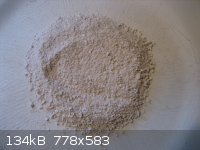
dried 2-naphthol
D. Results
The yield of 2-naphthol was 24.5g, vs the 25g predicted by Vogel. The melting point (sealed tube) was 110°C vs the literature value of 122°C .
Since this melting point indicated impure product I tested recrystallization of a sample in dilute (33%) alcohol. However the sample turned brown and
“oiled-out.” So, for now, I will leave the remainder “as is.”
E. Discussion
This is my 2nd caustic fusion to produce a member of the phenol family. The first was that for the synthesis of resorcinol. Although maintaining
safety during the time-temperature control of the fusion was again a challenge, overall, making 2-naphthol was much easier. This is due to two facts,
primarily: (1) oleum is not required in producing the sulfonate, as only a single sulfonic acid group is added, and (2) 2-naphthol is insoluble in
water, greatly simplifying the workup.
If I ever make 2-naphthol again I will wash the somewhat gummy product well with water before drying. This wasn’t called for by Vogel. Perhaps it
is just assumed to be part of good technique.
Questions, comments, and suggestions are welcomed.
[Edited on 15-12-2012 by Magpie]
The single most important condition for a successful synthesis is good mixing - Nicodem
|
|
|
UnintentionalChaos
International Hazard
    
Posts: 1454
Registered: 9-12-2006
Location: Mars
Member Is Offline
Mood: Nucleophilic
|
|
Nice work, as always, Magpie.
I'll probably be replicating this shortly since 2-ethoxynaphthalene is supposed to have an interesting fragrance.
Department of Redundancy Department - Now with paperwork!
'In organic synthesis, we call decomposition products "crap", however this is not a IUPAC approved nomenclature.' -Nicodem
|
|
|
Magpie
lab constructor
    
Posts: 5939
Registered: 1-11-2003
Location: USA
Member Is Offline
Mood: Chemistry: the subtle science.
|
|
Thank you. That's exactly what I was going to make, also called Nerolin. 
The single most important condition for a successful synthesis is good mixing - Nicodem
|
|
|
Magpie
lab constructor
    
Posts: 5939
Registered: 1-11-2003
Location: USA
Member Is Offline
Mood: Chemistry: the subtle science.
|
|
My recrystallization of a sample of crude 2-naphthol in 33% aqueous ethanol was partially successful. The lustrous appearance and color was much
improved. Here's a picture - sorry for the out-of-focus:
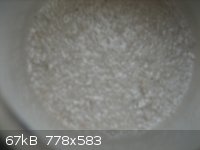
After drying at room temperature for 7 hours I determined the melting point. It was a much improved 120°C vs the lit value of 122°C.
The single most important condition for a successful synthesis is good mixing - Nicodem
|
|
|
UnintentionalChaos
International Hazard
    
Posts: 1454
Registered: 9-12-2006
Location: Mars
Member Is Offline
Mood: Nucleophilic
|
|
Man, any time I try to do something original, someone has me beat to the punch! You say that the recrystallization was partially successful? Did you
get a low recovery? I would call a 10C raise in mp a success. 
Department of Redundancy Department - Now with paperwork!
'In organic synthesis, we call decomposition products "crap", however this is not a IUPAC approved nomenclature.' -Nicodem
|
|
|
Magpie
lab constructor
    
Posts: 5939
Registered: 1-11-2003
Location: USA
Member Is Offline
Mood: Chemistry: the subtle science.
|
|
Yes, I agree. That was a poor choice of words. What I meant was that some of the 2-naphthol remained as a solid clump from the "oil-out" after
thoroughly cooling, but much of it recrystallized nicely.
I used food grade ethanol (from Everclear) for the recrystallization. I'm going to try it with solvent grade alcohol. Otherwise I may have to buy a
5th of cheap vodka to recrystallize the whole 24.5g. 
Boiling 33v/v% ethanol dissolves 3.4g 2-naphthol/100mL. But a significant fraction turned to oil.
In reference to the making of Nerolin, do you have a facile way of making ethyl iodide?
The single most important condition for a successful synthesis is good mixing - Nicodem
|
|
|
| Pages:
1
2 |